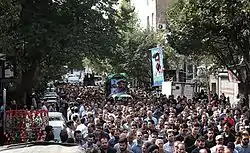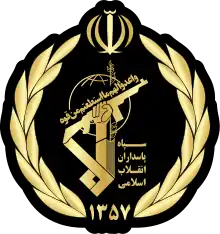
Holy Shrine Defenders, known in Persian as Modāfe'ān-e-Haram (مدافعان حرم), is a phrase used by the Iranian government to refer to their advisers and military personnel, whether Iranians or otherwise, fighting in Iraq and Syria in defense and protection of Shia peoples and holy shrines often targeted by Sunni fighters. The most prominent shrine associated with the mission of the "holy shrine defenders," and to which their presence in Syria is ostensibly dedicated, is the Sayyidah Zaynab Mosque in Damascus.
Background
| Part of a series on Islamism |
|---|
|
|
| Islamic Revolutionary Guard Corps |
|---|
 |
| Command |
|
Supreme Leader Commanders Joint Staff |
| Military branches |
|
Ground Forces Aerospace Force Navy Quds Force Basij |
| Intelligence agencies |
|
Intelligence Organization Intelligence Protection Organization |
| Personnel |
| Ranks insignia |
| Facilities |
|
Imam Hossein University Baqiyatallah University University of Command and Staff Amir Al-Momenin University |
The term "holy shrine defender" refers to advisers and military personnel who fight on behalf of Iran to defend and protect Shia sites and peoples in Iraq and Syria from groups such as ISIS, and in support of the government of Bashar al-Assad in Syria.[2] The term not only includes Iranians, but also Afghan and Pakistani fighters, such as those who fight with Liwa Fatemiyoun or Liwa Zainebiyoun.[3][4][5]
According to Speaker of the Iranian Parliament Ali Larijani, the "holy shrine defenders" guarantee the "security, awareness and dignity of the Iranian people" by fighting against ISIS.[6] The term itself begins to appear throughout Iranian media in 2013 in response to the perceived danger facing the Sayyidah Zaynab Mosque from Sunni rebels and an actual shelling of the shrine in July of that year.[7]
"Holy shrine defenders" is meant to evoke the memory of the Iran-Iraq War, often referred to in Persian as the Holy Defense (دفاع مقدس defā'-e moqaddas), and can further be connected to those fighting on the frontlines against Covid-19 in Iran, known as "health defenders" (مدافعان سلامت modāfe'ān-e salāmat).[8]
Involvement in Syria and Sayyidah Zaynab Shrine
The Damascene shrine of Zaynab bint Ali, daughter of Ali ibn Abi Talib, the fourth caliph of Islam and first Imam of Shia Islam, features prominently in Iranian state narratives about the involvement of "holy shrine defenders" in Syria. Protection of the shrine from outside attack, and possible destruction, has been used as a key mobilizing tactic for the Iranian state to attract Shia forces from across the region, especially those in Afghanistan who lived under Taliban rule.[9] Hezbollah has claimed the threats against the shrine are what motivated it to send fighters to Syria and Secretary General Hassan Nasrallah has called protecting the shrine "a duty".[10]
Despite the clear political aim of "holy shrine defenders" and other Iranian proxies to support the Assad government in Syria, the justification to be in Syria in order to protect and defend the shrine is not without merit. In April 2013, reports emerged that Al-Nusra Front, associated with Al-Qaeda in Syria, disinterred the dead body of Hujr ibn 'Adi and threatened to repeat this action at Zaynab bint Ali ’s shrine.[11][12][13]
Protecting the Sayyidah Zaynab Shrine features heavily in the experiences of "holy shrine defenders." Forces entering Syria often stop at Zaynab's shrine after first arriving and stop there before departing. It also serves as a prominent site for "holy shrine defenders" to participate in Ashura and Arba‘ein commemorations.[14]
Recognition and promotion in Iran
In Iran, "holy shrine defenders" are recognized by the state as martyrs for their role in defending both Shia Islam and the Islamic Republic. They are often given official funeral processions, sometimes coinciding with the death anniversary of a Shia Imam or alongside martyrs from the Iran-Iraq War, and buried in the designated martyr's section in cemeteries.[15]
Those "holy shrine defenders" who have been designated as martyrs are often depicted in funerary posters and other visual iconography, perhaps none more so than Mohsen Hojaji.[16] Hojaji's status as an iconic martyr of the "holy shrine defenders" can be seen in the multitude of depictions, such as those appearing on the billboard at Tehran's Vali Asr Square,[17] which seek to relate his image and death on the battlefield to the events occurring at the Battle of Karbala.
Other symbols related to the designated mission of the "holy shrine defenders," namely the Sayyidah Zaynab Mosque in Damascus, also feature heavily in iconography sponsored by the Islamic Republic and are used to create connections between current events and Shia history. Relating the experiences of Karbala to contemporary events has been an ongoing feature of state-sponsored narratives of national identity and belonging in the Islamic Republic, especially when faced with crisis.[18][19]
Subgroups
See also
References
- ↑ "خبرگزاری تسنیم - تشییع پیکر شهید مدافع حرم ابوالفضل نیکزاد". خبرگزاری تسنیم - Tasnim (in Persian). 2016-07-17. Retrieved 2017-09-14.
- ↑ "Iranian doc follows Afghan fighters in Syria - Al-Monitor: The Pulse of the Middle East". www.al-monitor.com. Retrieved 2021-08-16.
- ↑ Staff Writer (9 April 2018). "Iran confirms IRGC members death in Israel attack on Syrian airfield". trend. Retrieved 9 April 2018.
- ↑ "Liwa al-Fatemiyoun: Martyrdom Graphic". Jihad Intel. Retrieved 4 August 2018.
- ↑ "Iran: Afghan Children Recruited to Fight in Syria. Protection Gaps Increase Children's Vulnerability". Human Rights Watch. 1 October 2017. Retrieved 4 August 2018.
- ↑ "Speaker: Holy Shrine defenders guarantee Iran's security, dignity". The Iran Project. 2017-08-14. Retrieved 2017-09-14.
- ↑ Karouny, Mariam (2013-03-03). "Shi'ite fighters rally to defend Damascus shrine". Reuters. Retrieved 2021-08-29.
- ↑ "Going to War with the Coronavirus and Maintaining the State of Resistance in Iran". MERIP. 2020-09-01. Retrieved 2021-08-26.
- ↑ "Soleimani's Shadow". New America. Retrieved 2021-09-11.
- ↑ Barnard, Anne (2014-04-09). "Muslim Shrine Stands as a Crossroads in Syria's Unrest". The New York Times. ISSN 0362-4331. Retrieved 2021-09-11.
- ↑ "شكل گيري هسته هاي سپاه بين المللي شيعيان براي دفاع ازحرم حضرت زينب با نام ابوالفضل العباس". خبرگزاری مهر | اخبار ایران و جهان | Mehr News Agency (in Persian). 2013-05-08. Retrieved 2021-09-02.
- ↑ "مسؤول نبش قبر حجر بن عدی + عکس". fa.alalam.ir (in Persian). Retrieved 2021-09-02.
- ↑ "بزودی قبر زينب[ع] را هم نبش ميکنيم +عکس". مشرق نیوز (in Persian). 2013-05-04. Retrieved 2021-09-02.
- ↑ "اربعین فاطمیون در حرم حضرت زینب(س)+عکس- اخبار فرهنگ حماس - اخبار فرهنگی تسنیم | Tasnim". خبرگزاری تسنیم | Tasnim (in Persian). Retrieved 2021-09-11.
- ↑ Behnegarsoft.com (2019-06-29). "شیراز معطر به عطر شهدا شد + عکس - اسلايد تصاوير - عکس شماره 24 | ايثار". ايثار - پايگاه اطلاع رسانی بنياد شهيد و امور ايثارگران (in Persian). Retrieved 2021-08-23.
- ↑ "In pictures: How Iran remembers its war dead". Middle East Eye. Retrieved August 23, 2021.
- ↑ جدلية, Jadaliyya-. "The Mural Merry-Go-Round: The Vali Asr Billboard and Propaganda in Iran". Jadaliyya - جدلية. Retrieved 2021-08-23.
- ↑ Rolston, Bill (2020-02-01). "When everywhere is Karbala: Murals, martyrdom and propaganda in Iran". Memory Studies. 13 (1): 3–23. doi:10.1177/1750698017730870. ISSN 1750-6980. S2CID 159522978.
- ↑ Ram, Haggay (1994). Myth and Mobilization in Revolutionary Iran: The Use of the Friday Congregational Sermon. Washington, DC: American University Press. pp. 61–92.
- ↑ "استشهاد احد ابطال النجباء في سوريا". 19 December 2017.
